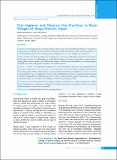Please use this identifier to cite or link to this item:
https://hdl.handle.net/20.500.14356/1326| Title: | Oral Hygiene and Tobacco Use Practices in Rural Villages of Jhapa District, Nepal |
| Authors: | Basnet, Bishal Babu Sharma, Khem Raj |
| Citation: | BasnetB. B., & SharmaK. R. (2020). Oral Hygiene and Tobacco Use Practices in Rural Villages of Jhapa District, Nepal. Journal of Nepal Health Research Council, 18(1), 59-63. https://doi.org/10.33314/jnhrc.v18i1.1906 |
| Issue Date: | 2020 |
| Publisher: | Nepal Health Research Council |
| Article Type: | Original Article |
| Keywords: | Oral health Smokeless tobacco Smoking Tobacco |
| Series/Report no.: | Jan-March, 2020;1906 |
| Abstract: | Abstract Background: Smoking and use of smokeless tobacco affect oral as well as general health. People are reluctant to achieve good oral health in lieu of the avoidance of deleterious habits. The objective of this study was to analyze two contrasting health behaviors; the oral hygiene practices against tobacco use in a sample from eastern Terai. Methods: This is questionnaire-based cross-sectional survey carried out in Jhapa district located in eastern Nepal. In this report, practice of toothbrushing, use of fluoridated toothpaste, frequency of using tobacco related products (paan, gutkha, chilim, cigarette, bidi, hukkah) was assessed. Association of health behavior to sociodemographic variables were tested with regression analysis at 95% confidence limits. Results: A total of 1178 respondents (response rate = 96.8%) completed the interview, among them 80.8% were males. Mean age was 52.21 years (SD = 15.943). Overall 72.6% used fluoridated toothpaste and toothbrush for cleaning teeth, 58.8% consumed tobacco related products. Interdental aids utilization was very less (1.2% using dental floss). Age was significantly related to both toothbrushing and tobacco-consuming. Educational status was related significantly to toothbrushing (p<0.05). Other sociodemographic variables (marital status, ethnicity, educational status) were not related to consumption of deleterious products (p>0.05). Conclusions: Our results showed that consumption of tobacco related products is moderately high in Terai village and oral health practice was found to be influenced by educational status. More such studies to identify status of oral health and impact of tobacco are recommended. Keywords: Oral health; smokeless tobacco; smoking; tobacco |
| Description: | Original Article |
| URI: | http://103.69.126.140:8080/handle/20.500.14356/1326 |
| ISSN: | Print ISSN: 1727-5482; Online ISSN: 1999-6217 |
| Appears in Collections: | Vol. 18 No. 1 (2020): Vol. 18 No. 1 Issue 46 Jan-Mar 2020 |
Files in This Item:
| File | Description | Size | Format | |
|---|---|---|---|---|
| 1906-Manuscript-14307-1-10-20200420.pdf | Fulltext Download | 206.11 kB | Adobe PDF |  View/Open |
Items in DSpace are protected by copyright, with all rights reserved, unless otherwise indicated.
